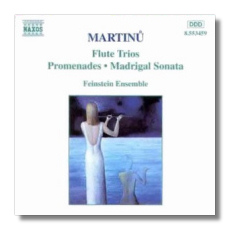
The Internet's Premier Classical Music Source
Related Links
- Martinů Reviews
- Latest Reviews
- More Reviews
-
By Composer
-
Collections
DVD & Blu-ray
Books
Concert Reviews
Articles/Interviews
Software
Audio
Search Amazon
Recommended Links
Site News
 CD Review
CD Review
Bohuslav Martinů

Chamber Works With Flute
- Trio for Flute, Cello & Piano
- Trio for Flute, Violin & Piano
- Promenades for Flute, Violin & Harpsichord
- Madrigal Sonata for Flute, Violin & Piano
Feinstein Ensemble
Naxos 8.553459 - 55min
It's no wonder that there's so much tension and unrest in this music. These pieces were composed between 1937 and 1944. The unspeakable horrors of World War II clearly took their toll on the sensitive Czech master.
The Flute-Violin-Piano Trio aspires to the neo-classical grace and elegance of Poulenc, but it's thwarted at nearly every turn by the disjointed rhythms, spiky dissonances, and shrill textures. The score dates from the year before the Nazi invasion of Czechoslovakia, but Martinů obviously sensed trouble looming on the horizon. I is a terse, restless sonata-allegro. The violin bravely tries to introduce a lyrical second subject, but she's quickly shouted down by the hyperactive piano. II is marked adagio, though the tempo is closer to andante here. The opening is sweet, tender, and gently flowing. The flute and violin engage in a poignant dialog that builds to a tremendous outpouring of grief at 2:50. III is a joyously chattering scherzo that's interrupted by an unexpectedly serene central section. Its gently arching, orientally-tinged flute theme is the most tender and magical moment in an otherwise manic score. The piano cadenza that begins the finale betrays the unmistakable influence of Prokofieff and Ravel combined with some bluesy harmonies and jazzy syncopations. The centerpiece of this movement is a soaring melody for the flute that leads to a touching dialog with the violin ala Janáček. The reflective mood is shattered at 3:35 by yet another assault from the piano, which introduces a reprise of the motoric music that opened the movement. The virtuosic Feinsteins are totally at ease with Martinů's elusive idiom and wildly shifting moods.
The Promenades begin innocently enough with a Bachian allegro and aria, both spiced with mildly piquant dissonances and violin glissandos. The instrumentation is the same as the preceding work, except that the piano has been replaced by a clattering harpsichord. Following the gentle aria, there is an abrupt change of mood. Suddenly, we enter a bizarre, nightmarish world. This music was, after all, written in 1939 while the composer was living in Paris. The scherzo is a brief (under two minutes), but spooky danse macabre, while the finale is bitter and edgy – a mad moto perpetuo propelled by the relentless twanging of the harpsichord. The conclusion anticipates the sound world of Philip Glass; fortunately this 'minimalist' passage is brief. Penelope Cave's harpsichord has a harsh, wiry sound. This may be due to the instrument or the recording. More likely, it is precisely the strident tone that Martinů intended.
The Madrigal Sonata is far more genial in tone. By the time of its composition, Martinů was safely ensconced in the United States and working diligently on his First Symphony for Serge Koussevitzky and his remarkable Boston Symphony. The security and safety that he must have felt at this stage in his career is certainly reflected in the warmth of the music. There are still occasional hints of the atrocities being perpetrated in the old world, but they pass quickly and are never allowed to dominate the musical argument. There are two brief movements – the second nearly twice as long as the first. The music is more richly contrapuntal than the other works on this program, which may account for the use of the word 'madrigal' in the title. (Martinů composed several other 'Madrigals' for various chamber ensembles in the late '30s and early '40s.) The score is full of melodic riches; the appealing flute theme at the beginning of II sounds like a distant cousin of the Shaker Hymn, "Simple Gifts". The playing of the Feinstein Ensemble is incisive and colorful.
Even more refreshing than the Madrigal Sonata is the Flute-Cello-Piano Trio of 1944. There are three movements. The first is a care-free allegretto with bird-like trills for the flute and a heart-warming parade of bright, attractive melodies. The rhythms are seductively syncopated in Martinů's trademark manner, and the development of the themes is inventive and compelling. The central adagio is calm and restful. A rhapsodic introduction for solo piano leads to a sinuous flute melody that evokes the beauties of the Czech countryside. The brief flute cadenza at the beginning of III continues the pastoral mood of the slow movement, but soon the flutist launches in to a jaunty, bustling allegretto. In the reflective central section, the flute and cello intertwine sensuously. The unhurried pacing of Martin Feinstein and his excellent ensemble allows this charming music to bloom splendidly. The cello, however, should have been given more prominence in the final mix.
The most serious complaint about this wonderful disc (other than the short playing time!) is the ordering of the selections. By placing the sunny Flute-Cello-Piano Trio first, the remaining works seem militant and unpleasant. If you purchase a copy for yourself, be sure to program your CD player to present these pieces in chronological order, thereby mirroring the composer's perilous wartime journey from nearly impenetrable darkness into brilliant, joyous light.
Copyright © 1997, Tom Godell




















